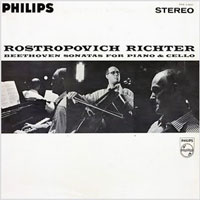Beethoven • Sonatas for Piano & Cello
Which brings us to our other contender, the subject of this Speakers Corner double-LP set. Like any live performance, the EMI is less than note-perfect, notable more for its gusto than its precision -- the gusts being a little too strong for some tastes. Rostropovich and Richter, recorded some six years earlier, offer a far more classically correct reading of these complex and involved pieces. Such all-star pairings can fall flat, as the egos compete for attention, but here the two "R"s strike a perfect instrumental balance, passing lead and support roles seamlessly from one to t’other as they effortlessly transit the two decades of musical development that separate the First and Fifth Sonatas. The performance, full of poise, control and contained power, is hard to fault, and if there are bones to be picked, they lie in the recording itself. Devoid of the unavoidable audience noise that intrudes on the EMI set, the Philips also lacks the explicit separation and scaling of the later recording. Instead, the instruments are big, bold and vibrant, full of bottom-end power and weight, but slightly pushed together. It’s a small price to pay for the expressive quality and technique that’s on display, while dynamics and impact are both excellent, the rendering of Richter’s left hand being particularly impressive. Tempi are flawless, and these two stellar performers certainly bring out the best from each other and the score. So which performance should you go for? With decent original copies of the EMI running out at around £80 a throw, it’s a bit of a moot point. Really, you should have both, so that you can enjoy the contrasting faces on either side of this musical coin. I wouldn’t want to be without the Barenboim/du Pre set, but the availability of a really good reissue of the Richter/Rostropovich is welcome indeed. My original pressing is definitely showing its age, and the Speakers Corner betters it in every department, but most notably in terms of its solid bottom end and smoother, less insistent treble. RCA, Mercury and Decca might get all the attention in the
collectable-record market, but it is a mistake to overlook the likes of Philips, whose
early "Hi-Fi Stereo" pressings offer impressive performances by many major
artists, captured in powerful recordings of great presence and sonic authority. This set
was no exception, and Speakers Corner has done a fantastic job of preserving its virtues.
This is one reissue that you can (and should) buy with complete confidence. |

 eethoven’s
five cello sonatas (although technically, the first two are sonatas for piano and cello,
rather than the other way round) are absolutely key pieces in the chamber repertoire, and,
like Bach’s cello suites, should be a cornerstone of any classical collection. If
Starker is a shoe-in for top spot on the Bach podium, the race for top honors when it
comes to the Beethoven is a much closer run, with two contenders ahead of the field. For
sheer emotional connection between the players and their instruments, it’s hard to
beat the musical intensity generated by the husband-and-wife pairing of Daniel Barenboim
and Jacqueline du Pre [EMI SLS 5042], a three-record set containing the five sonatas plus
three sets of variations. This live performance, captured by the BBC in 1970, is full of
energy, humor, drama and vivacious playing from both sides. The sound is tremendously
present, with a life-size, in-the-room image that sits you four or five rows back. Anybody
who thinks that chamber music is staid and conservative should listen to this; it’s
the musical equivalent of the chess game in the original Thomas Crowne Affair.
eethoven’s
five cello sonatas (although technically, the first two are sonatas for piano and cello,
rather than the other way round) are absolutely key pieces in the chamber repertoire, and,
like Bach’s cello suites, should be a cornerstone of any classical collection. If
Starker is a shoe-in for top spot on the Bach podium, the race for top honors when it
comes to the Beethoven is a much closer run, with two contenders ahead of the field. For
sheer emotional connection between the players and their instruments, it’s hard to
beat the musical intensity generated by the husband-and-wife pairing of Daniel Barenboim
and Jacqueline du Pre [EMI SLS 5042], a three-record set containing the five sonatas plus
three sets of variations. This live performance, captured by the BBC in 1970, is full of
energy, humor, drama and vivacious playing from both sides. The sound is tremendously
present, with a life-size, in-the-room image that sits you four or five rows back. Anybody
who thinks that chamber music is staid and conservative should listen to this; it’s
the musical equivalent of the chess game in the original Thomas Crowne Affair.